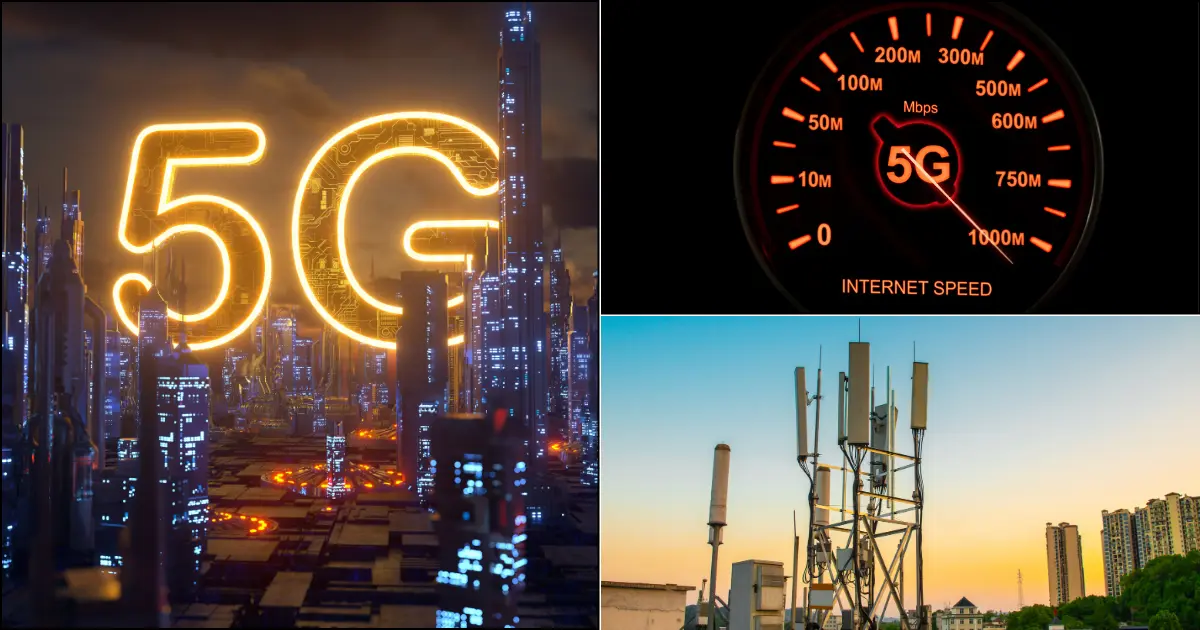In today’s rapidly evolving digital landscape, understanding 5G technology is essential for tech enthusiasts, students, and professionals alike. As the fifth generation of wireless technology, 5G promises unprecedented speed, lower latency, and enhanced connectivity that will transform various industries and everyday life. This comprehensive guide delves into the fundamental concepts of 5G, explores its key components like SIB3, GUAMI, and PCI, and examines its wide-ranging applications and future trends.
Table of Contents
The Importance of Understanding 5G Technology
5G technology is not just an incremental upgrade from its predecessors; it represents a significant leap forward in wireless communication. With potential applications spanning from autonomous vehicles and smart cities to advanced healthcare solutions and immersive virtual reality experiences, 5G is set to revolutionize how we interact with technology. For tech enthusiasts and professionals, grasping the intricacies of 5G is crucial for staying ahead in a world increasingly driven by connectivity and data.

Understanding 5G technology also equips students and professionals with the knowledge needed to develop and implement innovative solutions. As industries adopt 5G to enhance their operations, the demand for experts who comprehend its underlying mechanisms and applications continues to grow. This guide aims to demystify the complexities of 5G, making it accessible and understandable for a broad audience.
Key Concepts in 5G: SIB3, GUAMI, and PCI
To fully appreciate how 5G operates, it’s essential to understand some of its core components: SIB3, GUAMI, and PCI. These elements play pivotal roles in ensuring seamless connectivity and efficient network performance.
What is the Use of SIB3 in 5G?
System Information Block 3 (SIB3) is a critical component in the 5G network that facilitates the transmission of essential system information to user equipment (UE). SIB3 primarily contains information related to the access of the network, including:
- Tracking Area Information: Helps the UE understand the geographic area it is currently in, enabling efficient network management and mobility.
- Radio Resource Configuration: Provides details about available radio resources, ensuring optimal allocation and minimizing interference.
- Paging Information: Informs the UE about incoming calls or data, allowing the network to alert the device without maintaining a constant connection.
By managing these aspects, SIB3 ensures that devices can seamlessly connect to the network, maintain stable communication, and efficiently handle incoming data or calls. Understanding what is the use of SIB3 in 5G is fundamental for comprehending how the network maintains reliability and performance.
Explain the Function of GUAMI in the 5G Network
Globally Unique AMF Identifier (GUAMI) is another vital component in 5G networks. GUAMI acts as a unique identifier for the Access and Mobility Management Function (AMF), which is in charge of managing the connection and movement aspects of the UE.
The primary functions of GUAMI include:
- Network Identification: Ensures that each AMF can be uniquely identified across the global 5G infrastructure, preventing conflicts and ensuring accurate routing of data.
- Session Management: Facilitates the management of user sessions, allowing the network to track and maintain active connections effectively.
- Security and Authentication: Plays a role in the authentication processes, ensuring that devices are securely connected to the network.
By explaining the function of GUAMI in 5G networks, we gain insight into how 5G manages connections and maintains a secure, reliable communication environment for millions of devices simultaneously.
How PCI is Calculated from SSS in 5G
Physical Cell Identity (PCI) is crucial for identifying and managing cell towers within the 5G network. PCI helps prevent interference and ensures that UEs connect to the correct cell. The calculation how PCI is calculated from SSS (Secondary Synchronization Signal) in 5G involves several steps:
- SSS Detection: The UE detects the Secondary Synchronization Signal, which provides timing and cell identity information.
- Primary Identifier Extraction: From the SSS, the UE extracts primary synchronization information that aids in determining the overall cell identity.
- PCI Calculation: Using the extracted information, the network assigns a unique PCI to each cell. This calculation ensures that adjacent cells have different PCIs to avoid interference.
Understanding how PCI is calculated from SSS in 5G is essential for appreciating how the network minimizes interference and maintains efficient communication between multiple cells and devices.
How 5G Technology Works
At its core, 5G technology builds upon the advancements of previous generations but introduces new techniques and architectures to achieve superior performance. Here’s a simplified overview of how 5G works:
Advanced Radio Technologies
5G employs advanced radio technologies, including Massive MIMO (Multiple Input Multiple Output) and beamforming. Massive MIMO uses numerous antennas to transmit and receive data simultaneously, significantly increasing capacity and coverage. Beamforming directs the signal in specific directions rather than broadcasting uniformly, enhancing signal strength and reducing interference.
Spectrum Utilization
5G operates across a broader range of frequencies, including sub-6 GHz and millimeter wave (mmWave) bands. The use of mmWave frequencies allows for extremely high data rates and low latency, albeit with shorter range and higher susceptibility to obstacles. To mitigate these challenges, 5G networks deploy small cells—compact, low-power base stations that enhance coverage and capacity in densely populated areas.
Network Slicing
Network slicing is a revolutionary feature of 5G that enables the creation of multiple virtual networks on a single physical infrastructure. Each slice can be tailored to specific applications or industries, offering customized performance characteristics such as latency, bandwidth, and reliability. This flexibility allows operators to support diverse use cases, from autonomous driving to remote surgery.
Edge Computing
Edge computing complements 5G by processing data closer to the source, reducing latency and improving response times. By decentralizing data processing, edge computing ensures real-time data analysis and decision-making, which is crucial for applications requiring immediate feedback, such as augmented reality and industrial automation.
Enhanced Security
With the increased connectivity of 5G comes the need for robust security measures. 5G incorporates advanced encryption, authentication protocols, and network slicing to ensure data integrity and protect against cyber threats. These security enhancements are vital for maintaining trust and reliability in a highly connected environment.
Applications of 5G in Various Industries
5G technology’s transformative potential spans a wide array of industries, driving innovation and efficiency in unprecedented ways.
Healthcare
In healthcare, 5G enables telemedicine, remote surgeries, and real-time health monitoring. High-speed, low-latency connections allow for seamless communication between doctors and patients, even in remote locations. Additionally, 5G supports the use of advanced medical devices and sensors, enhancing patient care and enabling predictive analytics for better health outcomes.
Automotive
The automotive industry leverages 5G for developing autonomous vehicles and enhancing vehicle-to-everything (V2X) communication. Reliable, high-speed connections ensure that autonomous cars can communicate with each other and with infrastructure in real-time, improving safety and traffic management. 5G also facilitates over-the-air updates, allowing vehicles to receive the latest software enhancements without needing physical interventions.
Manufacturing
In manufacturing, 5G supports the Industrial Internet of Things (IIoT) by connecting machines, sensors, and robots. This connectivity enables real-time monitoring, predictive maintenance, and seamless automation, leading to increased efficiency, reduced downtime, and enhanced product quality. Additionally, 5G’s network slicing allows manufacturers to create dedicated networks for specific processes, ensuring optimal performance.
Entertainment and Media
5G revolutionizes the entertainment and media industry by enabling high-definition, immersive experiences such as virtual reality (VR), augmented reality (AR), and 360-degree video streaming. These technologies offer users unprecedented levels of interactivity and engagement, transforming how we consume and interact with digital content.
Smart Cities
5G plays a pivotal role in the development of smart cities by connecting various urban systems, including traffic management, energy grids, and public safety networks. This interconnectedness allows for efficient resource management, improved public services, and enhanced quality of life for residents. For example, smart traffic lights can adjust in real-time based on traffic flow, reducing congestion and emissions.
Agriculture
In agriculture, 5G enables precision farming by connecting drones, sensors, and machinery. Farmers can monitor crop health, soil conditions, and weather patterns in real-time, allowing for data-driven decisions that optimize yield and resource usage. Additionally, automated machinery connected via 5G can perform tasks with greater accuracy and efficiency, reducing labor costs and environmental impact.
Future Trends in 5G Technology
As 5G continues to evolve, several trends are shaping its future, promising even greater advancements and applications.
Integration with AI and Machine Learning
The integration of Artificial Intelligence (AI) and Machine Learning (ML) with 5G is set to enhance network optimization, predictive maintenance, and intelligent automation. AI algorithms can analyze vast amounts of data generated by 5G networks to identify patterns, predict issues, and optimize performance in real-time, ensuring that the network adapts dynamically to changing conditions.
Enhanced Security Protocols
With the increasing complexity of 5G networks, security remains a top priority. Future developments will focus on enhancing encryption techniques, developing more robust authentication methods, and implementing advanced threat detection systems. These measures will be crucial in safeguarding data and maintaining the integrity of 5G networks against evolving cyber threats.
Expansion of mmWave Deployment
While mmWave offers exceptional data rates and low latency, its deployment faces challenges due to limited range and high susceptibility to obstacles. Future trends indicate an expansion of mmWave infrastructure with more dense small cell deployments and advanced beamforming technologies. These advancements will enhance coverage and reliability, making mmWave a more viable option for widespread 5G adoption.
Satellite Integration
The integration of 5G with satellite networks is poised to extend connectivity to remote and underserved areas. By leveraging satellites, 5G can provide global coverage, bridging the digital divide and enabling seamless communication across the globe. This integration will be particularly beneficial for disaster recovery, maritime communication, and expanding internet access in rural regions.
Quantum Computing and 5G
Quantum computing holds the potential to revolutionize 5G by enabling unprecedented processing speeds and solving complex optimization problems. The synergy between quantum computing and 5G could lead to breakthroughs in network management, encryption, and data analysis, further enhancing the capabilities and performance of 5G networks.
Sustainable 5G
Sustainability is becoming a critical consideration in 5G development. Future trends emphasize the use of energy-efficient technologies, renewable energy sources for network infrastructure, and the reduction of electronic waste through recyclable materials. Sustainable 5G initiatives aim to minimize the environmental impact of expanding network infrastructure while maintaining high performance and reliability.
Conclusion: The Impact of 5G on Modern Connectivity
5G technology is ready to change modern connectivity, providing unmatched speed, dependability, and flexibility. From transforming industries like healthcare, automotive, and manufacturing to enabling smart cities and immersive entertainment, the applications of 5G are vast and impactful. Understanding the key concepts such as SIB3, GUAMI, and PCI provides a foundation for comprehending how 5G networks operate and manage connectivity efficiently.
As 5G continues to evolve, its integration with emerging technologies like AI, machine learning, and quantum computing will unlock even more possibilities, driving innovation and economic growth. The future of 5G holds immense potential, promising to enhance our lives and reshape the technological landscape in ways we have yet to imagine.
Explore Further into the World of 5G
Are you ready to dive deeper into the world of 5G technology? Whether you’re a student eager to learn more about the latest advancements, a professional looking to leverage 5G in your industry, or a tech enthusiast passionate about the future of connectivity, there’s always more to discover. Explore reputable resources, engage with online communities, and stay updated with the latest research to fully harness the potential of 5G technology.
References & Latest Articles
- Step-by-Step Guide to Upgrading from Windows 10 to Windows 11: Ensuring a Smooth Transition
- Top 5 Trends in Gaming Motherboards for 2024: What Every Gamer Should Know
- The Impact of Motherboard Specifications on Gaming Performance
- Future-Proof Your Gaming Setup: The Best Motherboards for 2025 and Beyond
- Choosing a Gaming Motherboard: Your Ultimate Guide for 2024
- Qualcomm. (2023). Understanding 5G: How It Works and Its Applications. Retrieved from Qualcomm 5G Overview
Want to learn more about our family-friendly tech blog? Check out our “Hello Read Me” for an introduction to our mission, topics, and more.



















What do you think?
Show comments / Leave a comment